White Tiger: The Elusive Ghost of the Jungle
The white tiger is majestic and elusive. It has a coat that looks like pale fire. This animal sparks scientific interest and cultural fascination. A snow white tiger prowling through mist is breathtaking. It makes us feel awe and respect. Similarly, the Marvel White Tiger stands for strength. Both evoke wonder in their own special ways. This remarkable tiger is rare in the wild but famous in our minds. It sits at the intersection of biology, myth, and modern stories.
Table of Contents
Scientific Classification
- Kingdom: Animalia
- Phylum: Chordata
- Class: Mammalia
- Order: Carnivora
- Family: Felidae
- Genus: Panthera
- Species: Panthera tigris
- Subspecies: Panthera tigris tigris (Bengal), Panthera tigris altaica (Siberian)
The white tiger isn’t its own species; it’s actually a color variation of the Bengal tiger and, on occasion, the Siberian tiger. This unique look comes from a rare genetic mutation known as leucism, which is distinct from albinism.
Description / Physical Description
The white tiger is truly a sight to behold. Its striking white fur, sometimes touched with a hint of gold, is adorned with bold black or charcoal stripes that zigzag across its body like beautiful calligraphy. It’s important to note that white tigers are not albino; they have captivating blue or green eyes, a pink nose, and dark-rimmed eyes that give them an intense, almost mesmerizing stare.
Adult male white tigers can weigh anywhere from 400 to 550 pounds (180 to 250 kg) and can stretch up to 10 feet long, including their tail. Females are a bit smaller but still pack a punch. With their powerful build, retractable claws, and strong jaws, they reign as apex predators. The striking black and white pattern is especially eye-catching in cubs and young tigers. Just look at an adorable white tiger cub; its fur is softer and fluffier than that of the adults, making it even more charming.
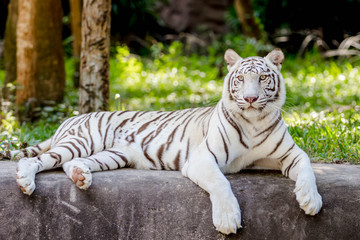
Range & Distribution
White tigers are primarily spotted in the wild across the Indian subcontinent, particularly in regions like Assam, Madhya Pradesh, Bihar, and West Bengal. Nowadays, most of the white tiger population resides in zoos and sanctuaries, largely due to habitat loss and selective breeding practices in captivity.
There have been unverified reports of white tigers in Siberia, which could potentially be white Siberian tigers, but no confirmed sightings of these wild specimens exist.
Habitat
White tigers share their homes with Bengal tigers, thriving in lush tropical and subtropical forests, mangroves, and grasslands. When they’re in captivity, we do our best to recreate this natural environment, providing spacious enclosures filled with logs, water features, and plenty of shaded areas.
While their light-colored fur might not be ideal for blending into the jungle, it’s perfect for snowy landscapes. The name “snow white tiger” really captures their ability to adapt to colder climates.
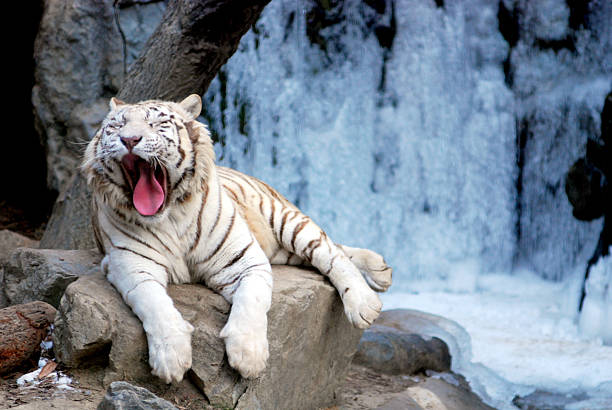
Diet
When it comes to their diet, white tigers are obligate carnivores, meaning they thrive on a protein-rich menu. In the wild, they typically hunt for:
– Sambar deer
– Chital
– Wild boar
– Water buffalo
In captivity, their meals are more controlled and usually consist of beef, chicken, rabbit, and some vitamin supplements. These magnificent hunters rely on their stealth and strength, often setting up a deadly ambush. With their powerful jaws and sharp canines, they are incredibly effective at catching their prey.
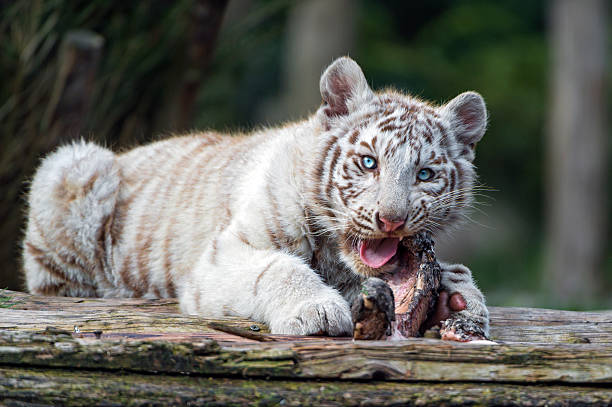
Behaviour / Lifestyle
White tigers are fascinating creatures that tend to be solitary and territorial, mostly coming alive at night. They cover vast territories and leave their scent on trees, which serves as a way to assert their dominance or signal their readiness to mate. Even though they prefer to keep to themselves, these big cats are also playful and quite intelligent.
In captivity, providing activities like puzzle feeders and swimming pools can help replicate their natural behaviors. White tigers have a real affinity for water; they’re excellent swimmers and can often be found enjoying themselves in ponds or rivers for hours on end.
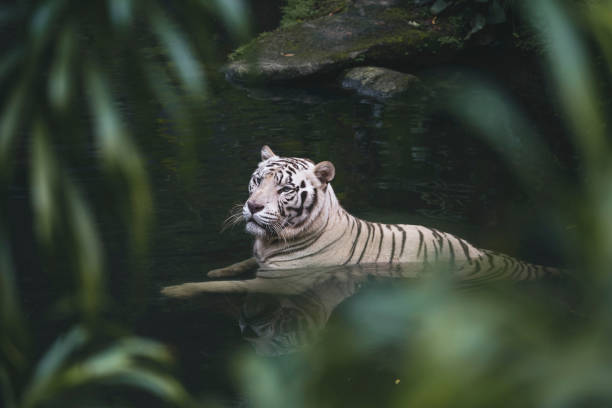
Lifespan
In the wild, a white tiger typically has a lifespan of around 15 years. Unfortunately, many wild tigers are often killed or captured when they’re still young. In contrast, those living in zoos and sanctuaries face fewer threats. With the right care and veterinary attention, they can thrive for 20 to 25 years.

Adaptations
White tigers possess a suite of adaptations that make them formidable predators:
- Powerful night vision enhances their ambush tactics.
- Muscular limbs support bursts of speed and pouncing.
- Retractable claws allow for stealthy movement and lethal swipes.
- Thick fur and skin protect against bites and environmental elements.
Their white coat might not help them hide in the jungle, but it works well in snowy areas. This adaptation is still uncertain when they are not in captivity.
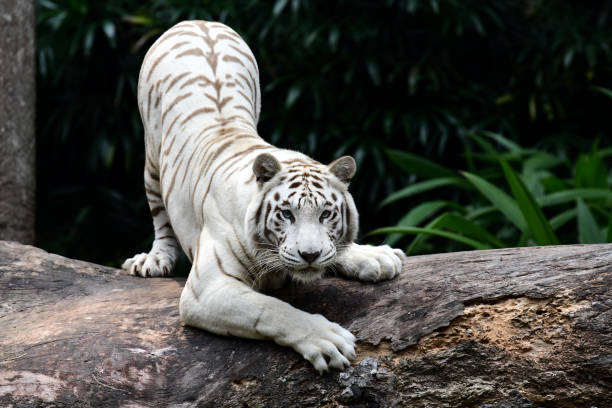
Mating & Reproduction / Reproduction & Lifecycle
When it comes to mating and reproduction, white tigers behave just like their Bengal tiger cousins. Female white tigers go into estrus several times throughout the year, signaling their readiness with distinct scents and vocalizations. After they mate, here’s what happens:
The gestation period lasts around 100 to 110 days.
Typically, a litter will have between 2 to 4 cubs, though sometimes there can be as many as 6.
The cubs are born blind and usually weigh about 1 kilogram.
By the time they reach 2 weeks old, the little ones start to take their first steps, and they’re weaned by 6 months.
Mothers are incredibly protective, spending up to two years teaching their cubs essential hunting and survival skills. Once that time is up, the young tigers are ready to venture out on their own.
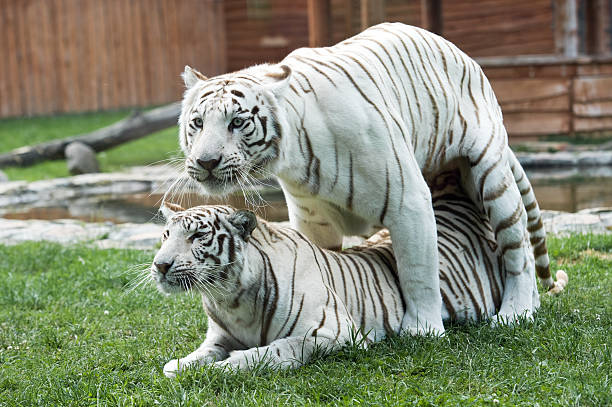
Predators
Adult white tigers face few natural predators aside from humans. However, cubs may fall prey to:
- Leopards
- Hyenas
- Other tigers
- Large snakes (pythons)
The biggest threat to them is human activity. This includes poaching, habitat destruction, and inbreeding in captivity.
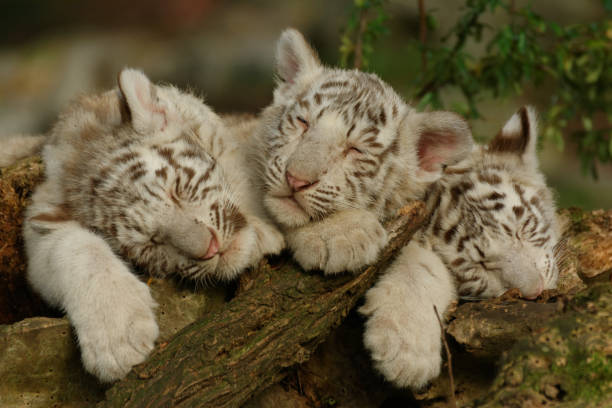
Conservation Status
When it comes to conservation status, white tigers aren’t classified as a distinct species by the IUCN. They actually belong to the Bengal or Siberian tiger groups. Bengal tigers are considered Endangered, and the white variant relies on captive breeding for its survival.
Currently, there are about 200 to 300 white tigers living in captivity worldwide. However, conservation efforts are often met with controversy, primarily due to the issues surrounding inbreeding. Inbreeding can lead to deformities and a decline in genetic health.
Interesting Facts
- Did you know some fascinating facts about white tigers? The most renowned among them is Mohan, who was captured back in 1951 and is actually the ancestor of many of today’s captive white tigers.
- In the Marvel universe, the White Tiger character embodies strength, agility, and justice, drawing its symbolic power from the elegance and rarity of the animal itself.
- Speaking of rarity, white tigers are quite uncommon. Unlike other tiger varieties, they only appear in about 1 in 10,000 births due to a genetic trait known as leucism.
- The term “the white tiger” has evolved into a global symbol, representing rarity, power, or even a hidden surprise. Its allure has been amplified by various books and films, making it even more popular.
As Pets
Keeping a white tiger as a pet is strongly discouraged and often illegal. These are wild cats. They need large territories, raw meat diets, and special vet care. Private ownership can lead to neglect, abuse, or harm for both people and animals.
White tigers deserve protection. They should live in sanctuaries or accredited conservation programs. We must not exploit them as trophies or status symbols.

Classification of Species
White tigers are genetically classified under:
- Panthera tigris tigris (Bengal)
- Rarely, Panthera tigris altaica (Siberian)
The white color comes from a recessive allele in the genes, passed down from both parents. This is not the same as albinism but rather a form of leucism—a partial loss of pigmentation.
Subspecies
White morphs have only been conclusively recorded in:
- Bengal tiger (Panthera tigris tigris)
- Speculatively: Siberian tiger (Panthera tigris altaica)
No white variants are confirmed for subspecies such as the Malayan, Indochinese, or Sumatran tigers.
Colours
While the most recognized form is the black and white tiger, variations include:
- Snow white tigers with nearly invisible stripes
- Golden tabby tigers, another rare color morph often resulting from inbreeding
- Stripeless white tigers, a product of intense selective breeding, with almost ghost-like appearances
These colors come from genetic manipulation in captivity, not from natural diversity. Breeding practices can be troubling. They often lead to serious genetic defects.In every sense—biological, cultural, and symbolic—the white tiger is a phenomenon. A living paradox: revered yet endangered, majestic yet man-made, natural yet rare. Wandering through old forests or as the White Tiger Marvel hero, this jungle ghost shows the wild’s surprising beauty.


